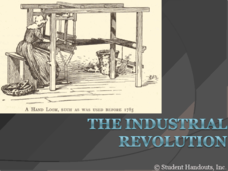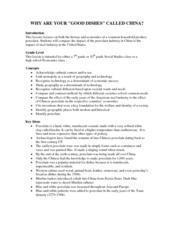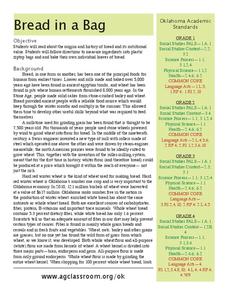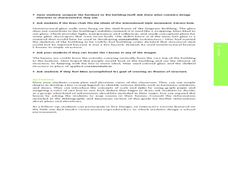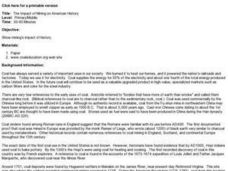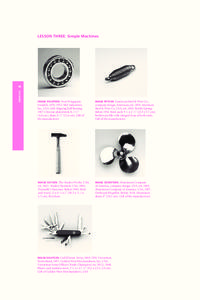Curated OER
Big Business & Industrial Cities
This is a true gem. This PowerPoint is well-organized, has bullet points you control (which gives you time for discussion), has sound effects, and covers several aspects of American industrialization after 1900. The presentation begins...
Library of Congress
Industrial Revolution
Could you live without your phone? What about cars, steel, or clothing? Class groups collaborate to produce presentations that argue that either the telephone, the gramophone, the automobile, the textile industry, or the steel industry...
Curated OER
The Industrial Age in America: Sweatshops, Steel Mills, and Factories
Students investigate the working conditions during the Age of Industrialization. They research how workers reacted to the conditions and discuss the results of labor movement.
Curated OER
The Industrial Revolution
Contrasting between the "Haves" and the "Have-Nots" of 18th-19th century Europe, this presentation explores the social and technological implications of the Industrial Revolution. Inventions, social trends, and scientific breakthroughs...
Curated OER
Was There an Industial Revolution? Americans at Work Before the Civil War
Young scholars tabulate the First Industrial Revolution where a significant number of inventions and innovations appeared transforming American life. Cite examples of change (ex. telegraph) in the lives of Americans during the era of...
Curated OER
Global Geography of Economics: the Indiana Steel Industry
Students research and identify positive and negative effects of imported steel on the Indiana steel industry.
Curated OER
Global Geography of Economics: The Indiana Steel Industry
Students are introduced to how steel is made and investigate the importance of the steel industry. They participate in a role-play that explores the concepts of taxes, tariffs and imports vs. domestic production.
Curated OER
The Inventions and Effects of the Industrial Revolution
Students understand that the Industrial Revolution began in England, spreading to the rest of Western Europe and the United States and with it came an increased demand for raw materials from the Americans, Asia, and Africa.
Curated OER
Worksheet #82 - Industrial Inventions
In this industrial inventions instructional activity, students expand their knowledge through ten fill in the blank questions that relate to the aforementioned topic.
Curated OER
The Roaring Twenties
Let's take a look back at America during the 1920s and 1930s. Information regarding the economics in the 1920s that led to some of the issues during the 1930s are covered using text and images. Learners will consider economic booms,...
Curated OER
History of Coal in the United States
High schoolers examine a timeline of coal mining in the US and research how the policies of coal dependent companies have changes over the last 50 years.
Curated OER
Chapter 9 - Big Business v. Labor
In this 20th century U.S. history learning exercise, students read assigned textbook pages regarding the industrialization and labor unions. Students then respond to 50 short answer questions.
Curated OER
Upton Sinclair's The Jungle: Muckraking the Meat-Packing Industry
Students explore muckraking. In this American history lesson plan, students listen to their instructor present a lecture regarding the details of Upton Sinclair's The Jungle. Students respond to discussion questions pertaining to...
Curated OER
Why Are Your "Good Dishes" Called China?
Students link monopoly as a result of geography and technology. They recognize technology as a determinant of economic success. Students recognize cultural diffusion based upon societal wants and needs. They compare and contrast methods...
Curated OER
Bread in a Bag
Could the history of bread really be interesting? Yes, it could! An informational text gives scholars wheat production background from 8,000 years ago, discussing different types of bread and the current industry in Oklahoma. Learners...
Curated OER
Waste, Then and Now
Students discuss and compare the waste disposal habits of today with those of Native Americans of long ago.
Curated OER
Exploring the Design Process
Students analyze the design process and architecture of Ludwig van der Rohe. In this architecture and art analysis activity, students explore the design process through photographic documentation and architectural plans. Students use...
Curated OER
618,000: Shall Not Have Died in Vain
Students explore the American Civil War. In this Civil War lesson, students examine a slave auction advertisement and an Abraham Lincoln quote. Students also read Pink and Say, create a foldable regarding naval warfare, and design a...
Curated OER
The Impact of Mining on American History
Students listen to background information about coal and its mining in the United States history. They then construct a timeline using the above article. Illustrate with pictures from the www.coaleducation.org web site.
Curated OER
Simple Machines
Students design objects in the Museum of Modern Art's collection of simple machines. In this simple machines instructional activity, students explore the machine age in the MoMA's design collection. Students identify simple machines and...
Curated OER
The Gilded Age & the Progressive Era (1877–1917)
In this online interactive philosophy worksheet, learners respond to 7 short answer and essay questions about the Gilded Age and Progressive Era in the United States. Students may check some of their answers on the interactive worksheet.
Student Handouts
A Society in Transition
Cover the 1980s in your class with a brief informational text and seven related questions. The one-page reading passage includes general information about jobs and skills, population patterns, and the AIDS epidemic.
Curated OER
Cartoons for the Classroom: Multinational Corporations
The octopus is a commonly used symbol in political cartoons. Help your scholars examine why it has been used in this way throughout history. Three cartoons depict different uses of the octopus. Background information helps gives context...
Curated OER
Discovering and Converting the Battle of Homestead
Students study and explore the Homestead strike and locate where the events took place. In this investigative lesson students use several perspectives to write an objective newspaper article on the event.





